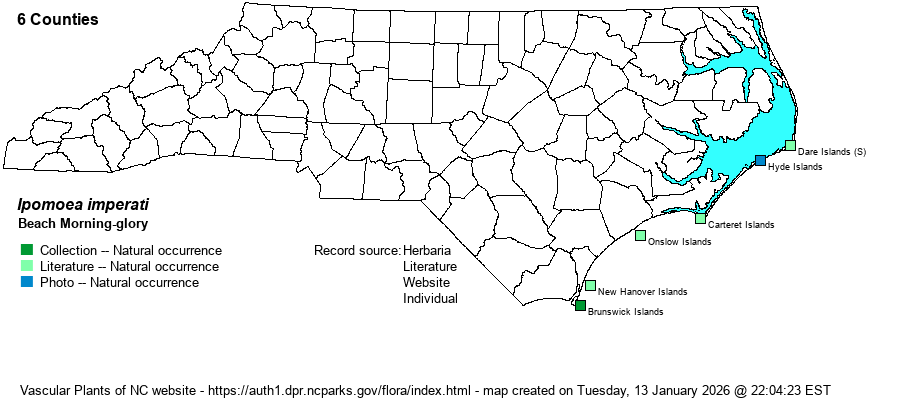| Author | (Vahl) Grisebach | |
| Distribution | Scattered along the immediate coast of barrier islands, north to Dare County. There are collections only from Brunswick County, but sightings/photos from New Hanover, Onslow, Carteret, and Hyde counties -- perhaps as no permits were held by observers for collecting plants on Federal or State lands? There is a photo on iNaturalist from Dare County, probably the southern portion of Hatteras Island.
This is a coastal/beach species in the South, ranging north to eastern NC, and south to southern FL and west to TX -- as well as much farther south. | |
| Abundance | Rare along the coast to Carteret County, and very rare to Dare County. This is a State Special Concern species. Individual populations are typically small, but in 2021 there were "thousands" of runners and flowers at Shackleford Banks, covering a mile-long stretch (Fussell pers. obs.). In 2021 Bob Peet observed "healthy populations" at Sunset Beach (Brunswick County). As a result of a number of more recent records in 2021 and 2022 -- many on iNaturalist -- the NCNHP moved the state Rank from a precarious S1 to a less rare S2S3. | |
| Habitat | In NC, the species is strictly found along the upper beach, in dunes, or in sandy areas behind dunes. The Shackleford Banks population occurs in low foredunes, extending into interdunes. |
| Phenology | Blooms from late June to October, and fruits shortly after flowering. | |
| Identification | This is a trailing herbaceous vine, growing to 8-10 feet or more, with leathery and shiny alternate leaves. Each leaf is at times oddly shaped; it is small for a morning-glory, only about 1.5-2 inches long. Many plants have unlobed leaves, wih the shape roughly rectangular, with a strong crease down the middle; other plants have leaves that are oddly 3-5 lobed, with each lobe rounded, the middle one the largest and usually narrowed at the base. The plant roots at some nodes, and from some leaf axils grow a single rather large white flower, with a yellow center (deep in the corolla tube), funnel-shaped and about 2 inches long and across, a bit smaller than most other species in the genus. The other white, beach-growing morning-glory -- I. macrorhiza -- has the flower mostly tubular, with a flaring distal end, rather than gradually open like a funnel. Also, its flowers have a purple center, and its large leaves are roughly triangular, thin and not fleshy, wrinkled, and serrated on the margins. | |
| Taxonomic Comments | This species was formerly named as I. stolonifera.
| |
| Other Common Name(s) | None | |
| State Rank | S2S3 | |
| Global Rank | G5 | |
| State Status | SC-V | |
| US Status | | |
| USACE-agcp | FACU link |
| USACE-emp | FACU link |

